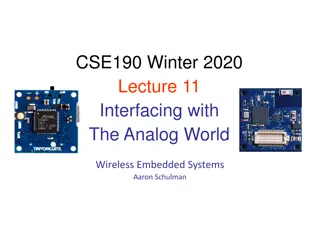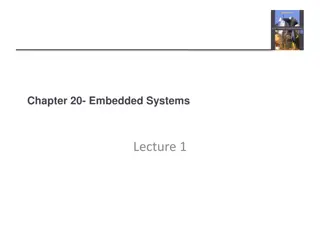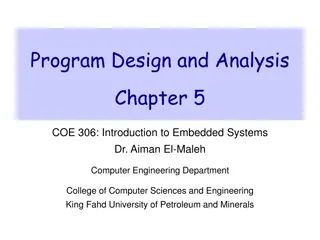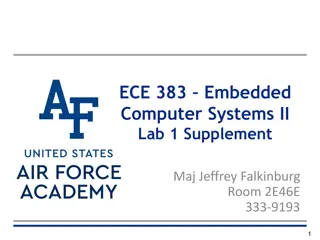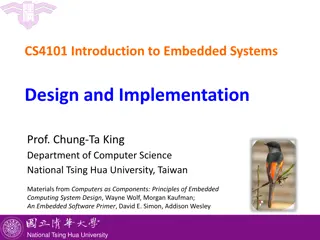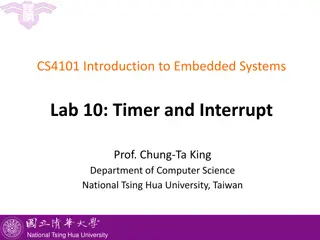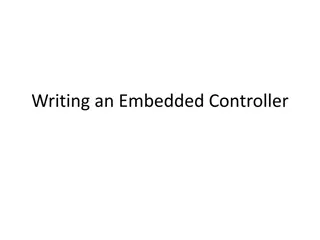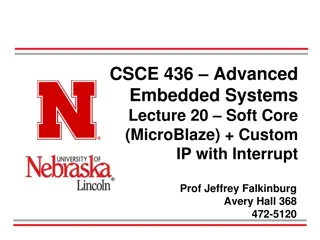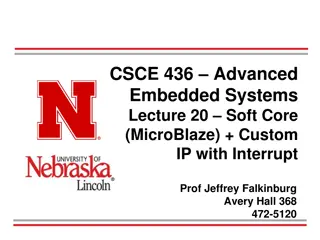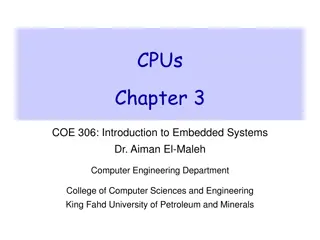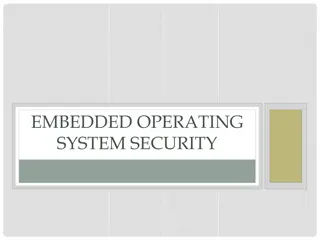Understanding Data Types and Operations in C Programming for Embedded Systems
Explore the importance of selecting appropriate data types and bitwise operations in C programming for embedded systems. Learn about the sizes of data types, performance considerations, ANSI C integer data types and their ranges, handling overflow issues, and coercion in programming. Enhance your knowledge to optimize memory usage, performance, and avoid potential errors in embedded system development.
Download Presentation

Please find below an Image/Link to download the presentation.
The content on the website is provided AS IS for your information and personal use only. It may not be sold, licensed, or shared on other websites without obtaining consent from the author. Download presentation by click this link. If you encounter any issues during the download, it is possible that the publisher has removed the file from their server.
E N D
Presentation Transcript
Chapter 1 C for Embedded Systems 1
Chapter Review Section 1.1: C Data types for Embedded Systems Section 1.2: Bit-wise Operations in C 2
Sizes of Data Types three methods to find out the exact sizes of the data types: 1. Read the compiler manual. 2. Use pseudo function sizeof(). 3. Use C99 data types. 3
Why should I care about which data type to use? Performance Overflow coercion 4
Performance Using 64-bit data type for saving 32-bit variable will cause: 1. Waste RAM resource 2. Twice RAM access time 3. Additional arithmetic instructions 5
ANSI C (ISO C89) integer data types and their ranges Range Max Data type Size Range Min -128 127 char 1 byte 0 255 unsigned char 1 byte -32,768 32,767 short int 2 bytes 0 65,535 unsigned short int 2 bytes -2,147,483,648 2,147,483,647 int 4 bytes 0 4,294,967,295 unsigned int 4 bytes -2,147,483,648 2,147,483,647 long 4 bytes 0 to 4,294,967,295 unsigned long 4 bytes -9,223,372,036,854,775,808 9,223,372,036,854,775,807 long long 8 bytes 0 18,446,744,073,709,551,615 unsigned long long 8 bytes 6
Overflow Unlike assembly language programming, high level language programs do not provide indications when overflow occurs and the program just fails silently. If you use a short int to hold the number of seconds of a day, the second count will overflow from 32,767 to -32,768. Even if your program handles negative second count, the time will jump back to the day before. 7
Coercion If you write a statement with different operand data types for a binary operation, the compiler will convert the smaller data type to the bigger data type. These implicit data type is called coercion. The compiler may or may not give you warning when coercion occurs. If the variable is signed and the data sized is increased, the new bits are filled with the sign bit (most significant bit) of the original value. When you assign a larger data type to a smaller data type variable, the higher order bits will be truncated. 8
ISO C99 integer data types and their ranges Data type Size Range Min Range Max 1 byte -128 127 int8_t 1 byte 0 to 255 uint8_t 2 bytes -32,768 32,767 int16_t 2 bytes 0 65,535 uint16_t 4 bytes -2,147,483,648 2,147,483,647 int32_t 4 bytes 0 4,294,967,295 uint32_t 8 bytes -9,223,372,036,854,775,808 9,223,372,036,854,775,807 int64_t 8 bytes 0 18,446,744,073,709,551,615 uint64_t 9
Bit-wise operators in C A B AND (A & B) 0 0 0 1 OR (A | B) 0 1 1 1 EX-OR (A^B) 0 1 1 0 Invert ~B 1 0 1 0 0 1 0 1 0 0 1 1 10
Setting and Clearing (masking) bits Anything ORed with a 1 results in a 1; anything ORed with a 0 results in no change. Anything ANDed with a 1 results in no change; anything ANDed with a 0 results in a zero. Anything EX-ORed with a 1 results in the complement; anything EX-ORed with a 0 results in no change. 11
Testing bit with bit-wise operators in C When it is necessary to test a given bit to see if it is high or low, the unused bits are masked and then the remaining data is tested. Example: if (var1 & 0x20) 12
Bit-wise shift operation in C Operation Symbol Format of Shift Operation Shift Right >> data >> number of bit-positions to be shifted right Shift Left << data << number of bit-positions to be shifted left 13
Compound Operators Instruction Its equivalent using compound operators a += 6; a = 23; y *= z; z /= 25; w |= 0x20; v &= mask; a = a + 6; a = a 23; y = y * z; z = z / 25; w = w | 0x20; v = v & mask; m = m ^ togBits; m ^= togBits; 14
Bit-wise operations using compound operators The majority of hardware access level code involves setting a bit or bits in a register, clearing a bit or bits in a register, toggling a bit or bits in a register, and monitoring the status bits. For the first three cases, the compound operators are very suitable. 15
Using shift operator to generate mask One way to ease the generation of the mask is to use the left shift operator. To generate a mask with bit n set to 1, use the expression: 1 << n If more bits are to be set in the mask, they can be or together. To generate a mask with bit n and bit m set to 1, use the expression: (1 << n) | (1 << m) register |= (1 << 6) | (1 << 1); 16
Setting the value in a multi-bit field register |= 1 << 30; register &= ~(1 << 29); register |= 1 << 28; register &= ~(7 << 28); register |= 5 << 28; register = register & ~(7 << 28) | (5 << 28); 17





